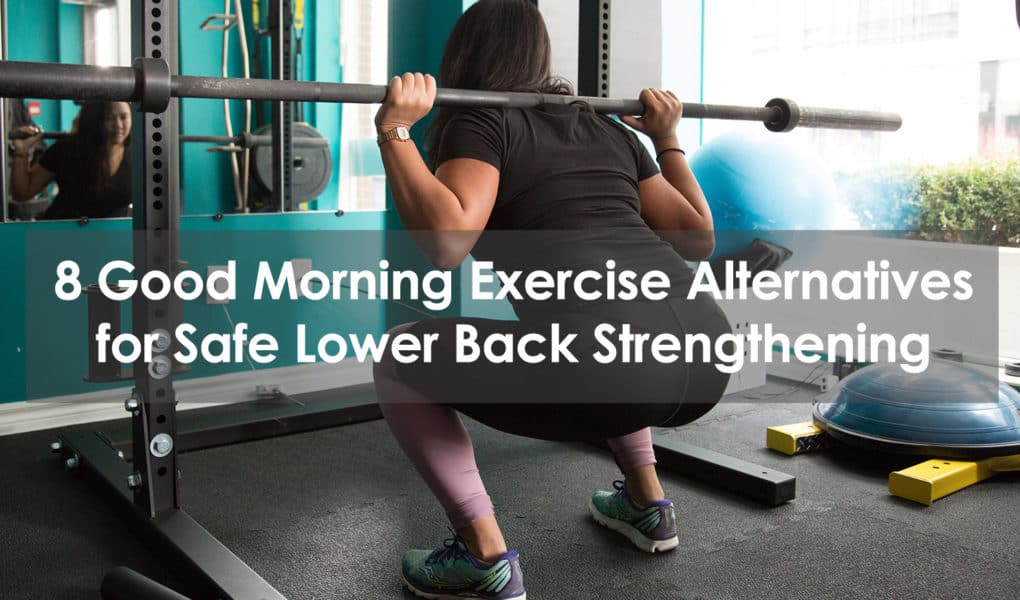The good morning exercise has been a popular exercise for decades in the strength and conditioning world as an accessory posterior chain exercise, to strengthen hip extension and the spinal erectors.
Because of the advanced nature of the good morning exercise, without proper form, and when using heavier weight, this exercise carries a relatively high risk of injury. Although it can be a great accessory exercise, if you’re looking for an alternative effective exercise with the same benefits and less risk, there are alternative exercises available.
It is important to find ways to strengthen the hamstrings, as they are the most frequently injured muscle in sports. Luckily, several exercises in this article have been found to maximize hamstring muscle activation and prevent injury.
So, here are some of our favorite good morning exercise alternatives to use in your exercise routine!
1. Bent Rows
This is an awesome exercise for the whole posterior chain. It involves the bottom position of a good morning, but with the added benefit of bringing in the upper back muscles. You can do this exercise with dumbbells, a barbell, or other forms of resistance.
Instructions:
- Assume the starting position, with the feet shoulder-width apart and the upper body parallel to the floor.
- With the barbell at the level of the knees, squeeze your shoulder blades back as you pull the bar through a full range of motion into your stomach.
- Perform 6-8 reps, as you will be able to use relatively heavy weights with this movement.
2. Stiff-Legged Deadlifts
This is a great deadlift assistance exercise, and they also closely mimic the muscle activity of good mornings. You might also like to try Romanian deadlifts if you lack hamstring flexibility, another excellent hamstring exercise that requires slightly less mobility.
Instructions:
- Start with the feet hip-width apart, with a barbell or dumbbells in front of the hips.
- Keeping your knees straight but not locked, slowly lower the weight down as far as you can while getting a good stretch in the hamstrings.
- Keep the back straight as you squeeze up to the starting position for 10-12 reps.
3. Glute Bridges
These are foundational strength movements for building glutes strength. They are also a great way to start building strength without being limited by weaker grip strength, as you can rest weight on the front of your hips rather than hanging onto a bar, as is required with deadlift strength exercises.
Instructions:
- Lay on your back with the knees bent and feet flat.
- Squeezing your glutes, lift your hips as high as possible, contracting at the top before slowly lowering down.
- This can be one of your high-rep bodyweight exercises, or you can add additional weight with a barbell version to really test your hip extension strength.
- For the heavy barbell version, stick with 6-10 reps.
4. Single-Leg Deadlift
This is another essential hip movement that activates the core muscles along with the posterior muscles. Using a single leg to balance will work the glutes and hamstrings like nothing else! A great athletic alternative to heavy deadlifts.
Instructions:
- Start with a single leg stance foot position, holding the weight in front of the hips.
- From here, perform a hip-hinge motion, bringing the weight to the standing knee, before contracting up to the standing position.
- Try 10 reps on each leg, all in a row or alternating feet.
5. Bird Dogs
This move is perfect for any fitness level. This bodyweight-only exercise requires only a mat for those with any knee injury. This exercise will work your core, balance, and the entire posterior chain from one side to the other.
Instructions:
- From all fours, with the shoulders over the hands and the hips over the knees, raise one arm and the opposite leg to parallel.
- Squeeze and hold with the glutes and upper back muscles, keeping the core contracted.
- Slowly lower down and repeat with the opposite arm and leg.
- Go for 10-12 repetitions all up.
6. Back Extensions
Using the back extension machine is an excellent way to mimic the hip hinge exercise of the good morning, without uncomfortably loading the spine. As they’re known, Hyperextensions can be done the conventional way or as reverse hypers, and open-chain version in which the upper body is anchored and the feet lift up and down.
Instructions:
- With the legs anchored in the machine, hold a weight plate across the chest.
- Activate the spinal erectors, glutes, and hamstrings as you raise the torso to an upright position.
- Hold at the top for two seconds, and repeat for up to 15 repetitions.
7. Glute Ham Raise
Another ideal home workout exercise, this movement focuses on the contraction of the erector spinae or lower back muscles. This is also a good exercise to improve your posture, as it activates the muscles that pull your shoulder blades back.
Instructions:
- Lay face down on the floor or a mat and reach your arms forward.
- Squeezing from the glutes first, lift your hands and feet off the floor and hold for two seconds.
- If this movement is too difficult at first, you can alternate opposite hand and foot for a less intense version.
- Perform for 10 or more reps for endurance.
Conclusion
We hope this article has given you some good ideas for how to strengthen your posterior chain without having to do good mornings if you’d prefer not to perform this exercise.
Frequently Asked Questions
Are good mornings a compound exercise?
Good mornings are a compound exercise, as the movement crosses multiple joints. Being a posterior chain movement, good mornings engage muscles across the ankle, knees, hips, and spine, making it an exercise that covers many muscle groups in one movement.
How many good mornings should I do?
Good mornings can be programmed like any other exercise in terms of being informed by your goals. As an accessory exercise, you wouldn’t necessarily be performing heavy weight for low repetitions with this movement. A typical prescription for good mornings would be 2-3 sets of 12-20 repetitions.
Is the good morning exercise bad?
While the good morning is a somewhat controversial exercise in terms of whether to include it in your program, it is not an inherently unsafe or dangerous exercise. Obviously, while placing a load on the shoulders and engaging in hip flexion can be a precarious position, if done with good technique and appropriate loading, this exercise does have its place where required.







